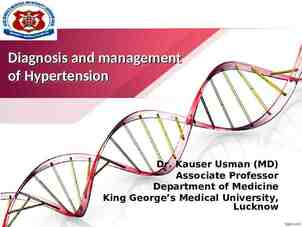Assessment of the Musculoskeletal System Sara H. Mitchell, Ph.D.,
35 Slides902.00 KB
Assessment of the Musculoskeletal System Sara H. Mitchell, Ph.D., RN, CPNP
The impact of diseases of the musculoskeletal system 1. 2. 3 4 5 6.
Composition of the Musculoskeletal System The skeleton proper (bones & joints) Skeletal muscles Tendons Ligaments
Nutrition & Musculoskeletal Function Fluoride Aluminum Magnesium Copper Zinc Iron Manganese Iodine
Assessment of the musculoskeletal system History-taking Inspect & Palpate joints Assess range of motion Assess muscle strength 1 2 3 4 5
Joint motion - a review of terms Flexion Extension Dorsiflexion Plantar flexion Adduction Abduction Inversion Eversion Internal rotation External rotation Pronation Suppination
Measuring Range of Motion If any limitation or increase in ROM is noted, use a to measure the angles precisely
Cervical Spine Assessment Abnormal findings H A T
Upper Extremity Assessment Abnormal findings: L P S M A C
ROM of wrist & hand Flexion – Extension – Hyperextension – Ulnar deviation – Radial deviation –
Spinal Assessment Abnormal findings: S T S
Torso Range of Motion Abnormalities: L P
Lower Extremity ROM Hip flexion with knee straight – Hip flexion with knee flexed: Internal & External rotation : Abduction : Adduction :
Range of Motion of the Knee Flexion-extension – 1350 Hyperextension - 100
Ballottement Used to test for joint effusion If there is an effusion present a palpated tap will be present and the transmitted impulse will be felt by the fingers on either side of the patella
Ankle Range of Motion Dorsiflexion – 20o Plantar Flexion – 500 Inversion of hind foot – 50 Eversion of hind foot - 50
Alterations of Musculoskeletal Function Musculoskeletal Injuries n s s Disorders of bone m I b Disorders of joints i Disorders of skeletal muscle s m m I
Primary symptoms of musculoskeletal disease P W D L S J
Phalen’s test Ask the person to hold both hands back to back while flexing the wrists 90 degrees. Acute flexion of the wrist for 60 seconds produces numbness and burning in a person with carpal tunel syndrome
Tinel’s Sign In carpal tunnel syndrome, percussion of the median nerve produces burning and tingling along its distribution, which is a positive Tinel’s sign
The musculoskeletal system of the young C E B S
Musculoskeletal assessment in the pediatric patient O Limp T L G G S L I S
Maneuver for Congenital Dislocated Hip With a dislocated hip, the head of the femur is not cupped in the acetabulum but rests posterior to it. Hip instability feels like a clunk as the head of the femur pos into place. This is a positive
Lower Extremity Findings in Children : “bowlegged” stance is normal through the first two years of life. Resolves with growth and ambulation : knockkneed stance occurs normally between 2 and 3½ years of age
Dislocation of the hip functionally shortens and weakens hip and pelvis muscles. When a child stands on the dislocated hip, the opposite side of the pelvis drops
Scoliosis scoliosis is flexible. It is apparent with standing and disappears with forward standing. scoliosis is fixed. The curvature shows both on standing and on bending forward
The Musculoskeletal system of the elderly Muscle atrophy Osteoporosis Kyphosis Decreased intervertebral disc space Joint stiffness Osteoarthritis Reduced range of motion Degenerative changes
Degenerative Joint Disease of Osteoarthritis Osteoarthritis is characterized by hard, nontender nodules, 203 mm or more. These osteophytes (bony overgrowths) of the distal interphalangeal joints are called nodes and those of the proximal interphalangeal joints are called nodes
Osteoporosis Risk Factors Classification Diagnosis Prevention Treatment Areas of yellow indicate bone loss from osteoporosis
The Musculoskeletal system of the elderly (continued) “Musculoskeletal problems have the most significant impact on the aged population. More than 1 billion dollars is spent annually by Medicare for hospitalization of elderly patients with these conditions. This represents 20% of all Medicare payments.
Reaching a conclusion Based on history & physical examination does there appear to be a musculoskeletal disease or impairment? Do the history and finding suggest a primary musculoskeletal concern or signs & symptoms of a systemic disease? What is the differential diagnosis? What additional tests (labs, diagnostic studies) are indicated?
Differential diagnoses - what is the primary problem Fracture Sprain Dislocation or subluxation Joint or muscle inflammation Age specific abnormality Systemic illness (examples) neuropathy myopathy connective tissue disease
Test for musculoskeletal function Bone function a a M a g s r a b b Joint function Muscular function S , U EMG f m
Remember. “Diseases of the musculoskeletal system rank first among disease conditions that alter the quality of life the cost of which exceeds 60 billion dollars annually ”








































